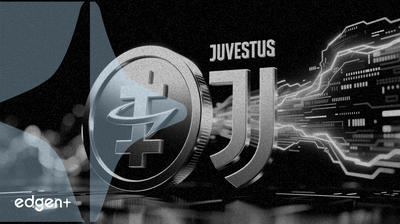Back


## Executive Summary Tether, the operator of the **USDT** stablecoin, has submitted an all-cash proposal to acquire **Exor's** 65.4% controlling stake in the Italian football club **Juventus FC**. The bid is coupled with a commitment to inject an additional $1 billion into the club upon completion. This move represents a significant strategic push by a major crypto-native entity into the world of traditional sports, aiming to leverage its substantial capital reserves to acquire a globally recognized brand and stabilize its financial footing. ## The Event in Detail The proposal outlines a two-pronged financial strategy. First, an all-cash acquisition of **Exor's** majority shareholding would transfer control of the club to **Tether**. Second, a subsequent $1 billion capital infusion is earmarked for clearing existing debts and investing in the club’s operational and competitive capacity. The transaction, if successful, would mark one of the most high-profile intersections of the digital asset industry and legacy institutions, potentially delisting Juventus and taking it into private ownership under the crypto giant. ## Financial Mechanics and Strategic Context European football clubs are often characterized by substantial debt loads. **Manchester United** (NYSE: MANU), for instance, recently reported its net debt exceeded $1 billion following a leveraged buyout. Other clubs have pursued complex financing structures to manage liabilities. **AC Milan** recently sought a private credit holdco loan of approximately $600-700 million to refinance debt held by its previous owner, Elliott Investment Management, utilizing instruments with payment-in-kind (PIK) options. In this context, **Tether's** all-cash offer presents a starkly different approach. Rather than leveraging the asset to finance its own purchase, **Tether** aims to use its existing capital to deleverage the club entirely. This strategy is less akin to the leveraged buyouts common in sports and more similar to a strategic acquisition by a cash-rich private corporation, such as **Mars, Incorporated's** recent $36 billion all-cash takeover of **Kellanova**. The move would provide **Juventus** with a clean balance sheet, a significant competitive advantage in a capital-intensive industry. ## Broader Market Implications A successful acquisition would serve as a major validation for **Tether** and the broader cryptocurrency ecosystem. For **Tether**, it represents a strategic diversification, deploying its vast reserves into a high-profile, non-digital asset. This could enhance its legitimacy and demonstrate a long-term vision beyond the confines of the crypto markets. The deal could also establish a new playbook for crypto-native firms, proving that profits generated in the digital asset space can be effectively deployed to acquire and revitalize major brands in the physical world. Such a move signals a maturation of the industry from speculative trading to strategic corporate finance, potentially encouraging other crypto firms to pursue similar acquisitions of legacy assets in sports, media, and other sectors. ## Expert Commentary and Precedents Market observers note that the proposed acquisition will face intense regulatory scrutiny, similar to any major cross-border M&A transaction. The unconditional approval of the **Mars-Kellanova** deal by 28 regulatory bodies worldwide provides a recent precedent for the complexities involved. Regulators will likely focus on the source of funds and the long-term stability of the acquiring entity. While the deal is unconventional, there is demonstrated investor appetite for high-profile, transformative ventures, as seen in the market anticipation for a potential **SpaceX** IPO. Analysts suggest that **Tether** is providing the "steak"—a substantial cash injection—for the "sizzle" of a globally renowned football brand. The success of this bid would not only alter the financial landscape of European football but also redefine the boundaries between the digital and traditional economies.

## Executive Summary Ripple is strategically expanding the utility of its native digital asset, **XRP**, by making it available on the **Ethereum** and **Solana** blockchains. This initiative is designed to integrate **XRP** into the broader Decentralized Finance (DeFi) ecosystem, moving beyond its traditional use case in cross-border payments. The expansion leverages bridging technology to create wrapped versions of **XRP**, allowing it to interact with smart contracts and applications on these leading DeFi platforms. ## The Event in Detail The launch of **XRP** on **Ethereum** and **Solana** is facilitated through cross-chain bridges, with **Hex Trust** and **LayerZero** being identified as key technology partners. This mechanism involves locking native **XRP** on its own ledger and issuing an equivalent, "wrapped" **XRP** token (wXRP) on the target blockchain. This wrapped token is fully collateralized by the native asset, ensuring price parity. This technical approach allows **XRP** to gain the functionalities of an ERC-20 token on **Ethereum** or an SPL token on **Solana**. As a result, holders can utilize their **XRP** in a wide array of DeFi applications, including decentralized exchanges (DEXs) like Uniswap or Serum, lending protocols such as Aave and Compound, and various yield farming platforms native to these ecosystems. ## Market Implications This expansion has the potential to significantly increase **XRP**'s liquidity and trading volume by tapping into the deep liquidity pools of the **Ethereum** and **Solana** DeFi markets. For traders and developers on these platforms, it introduces a new, highly liquid asset for trading pairs, collateralization, and other financial strategies. However, the move also introduces competition for existing assets within these ecosystems. The success of wrapped **XRP** will depend on its adoption rate by DeFi protocols and the willingness of users to bridge their assets. The primary implication is the transformation of **XRP** from a payment-focused asset into a more versatile instrument for decentralized financial services, potentially increasing its overall utility and demand. ## Expert Commentary The strategic pivot towards broader utility aligns with Ripple's recent regulatory achievements. Following the conditional approval from the Office of the Comptroller of the Currency (OCC) for a national trust bank charter, Ripple CEO **Brad Garlinghouse** emphasized the company's focus on compliance and innovation. In a statement regarding the OCC's decision, he noted it was a "massive step" for the industry, highlighting a commitment to operating under federal supervision. Market analysts have viewed these parallel developments favorably. One expert, known as 'Steph is Crypto,' described the imminent approval of the bank license as a "bullish" catalyst for **XRP**, a sentiment echoed by others in the financial community who see regulatory clarity as a precursor to institutional adoption. ## Broader Context Ripple's multi-chain strategy and its pursuit of a national trust bank charter are interconnected components of a larger objective: to embed **XRP** and related services within the regulated financial system. By obtaining a federal charter, Ripple can offer custody and settlement services for digital and traditional assets under direct federal oversight. This status is crucial for attracting institutional clients who require regulated counterparties. The approval also paves the way for the integration of Ripple's planned stablecoin, **RLUSD**, into the U.S. banking system. A recent OCC ruling allowing national banks to use digital assets for settlement further strengthens this position. This dual-pronged approach—expanding into decentralized ecosystems while simultaneously securing a foothold in traditional finance—positions Ripple to bridge the gap between the two, a strategic goal shared by other major players like **Circle** and **Paxos**, which also received conditional OCC approval.

## Executive Summary Interactive Brokers has announced that it will now accept stablecoins for funding retail investor accounts. This decision represents a strategic move to remain competitive as the financial services industry increasingly integrates digital assets. The feature is set to be introduced through a gradual rollout, beginning with a portion of the firm’s eligible U.S. client base. The initiative signals a significant step in bridging the gap between traditional financial markets and the digital currency ecosystem. ## The Event in Detail According to the announcement, retail investors at **Interactive Brokers** will have the ability to deposit stablecoins directly into their trading accounts. This initiative is designed to enhance the efficiency and speed of funding compared to traditional methods. The firm has positioned this move as a necessary step to maintain its competitive position in a rapidly evolving financial landscape where digital assets are becoming more prevalent. The initial phase will target a select group of U.S. customers, with plans for broader availability to follow. ## Deconstruct the Financial Mechanics This integration allows investors to use fiat-pegged stablecoins, such as **USDC**, as a direct funding instrument. Unlike traditional bank transfers (ACH or wire), which are subject to banking hours and can take several business days to settle, stablecoin transactions can be processed nearly instantaneously, 24/7, on their respective blockchain networks. This mechanism reduces settlement times and can lower transaction costs, offering a more efficient on-ramp for deploying capital into securities markets. By leveraging blockchain infrastructure, the process bypasses conventional payment rails for the deposit leg of the transaction. ## Market Implications The decision by **Interactive Brokers** is expected to increase competitive pressure on other major brokerage firms to adopt similar capabilities. As investors grow accustomed to the speed and convenience of digital asset transactions, brokerages lacking these on-ramps may face a competitive disadvantage. This development is also poised to accelerate the mainstream adoption of stablecoins, normalizing their use as a standard financial tool for transferring value rather than as purely speculative crypto assets. It provides a key utility by creating a more fluid connection between the digital economy and traditional investment platforms. ## Expert Commentary and Broader Context This move by **Interactive Brokers** aligns with a broader trend of established financial companies integrating stablecoin technology. **Visa**, for instance, has already moved to incorporate stablecoins into its global payments network. **Yanilsa Gonzalez-Ore**, a senior vice president at **Visa Direct**, noted the company is at the "forefront of real-time payments and emerging technologies, like AI and stablecoins." In November, **Visa** launched a pilot program enabling stablecoin payouts in **USDC** for creators and gig economy workers, demonstrating the viability of using digital currencies for faster, more efficient global payments. These actions by major financial incumbents like **Visa** lend significant credibility to the strategic path **Interactive Brokers** is now pursuing, framing it as a necessary adaptation to modern financial infrastructure.